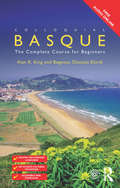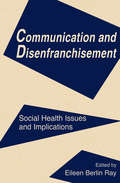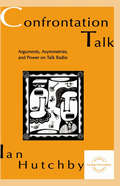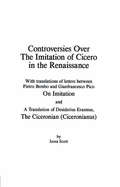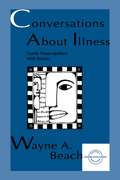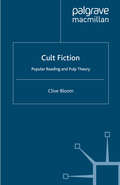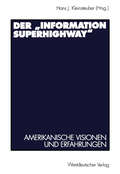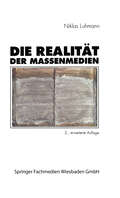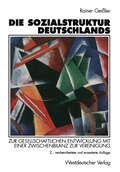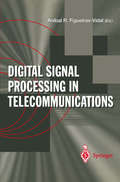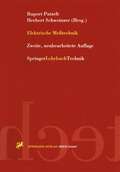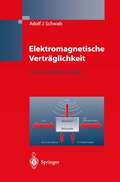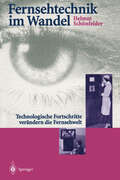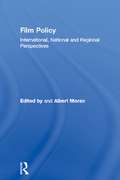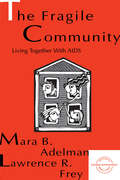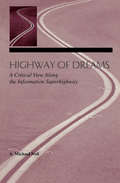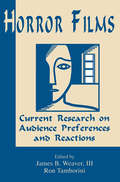- Table View
- List View
Colloquial Basque: A Complete Language Course
by Begotxu Olaizola Elordi Alan R. KingColloquial Basque: The Complete Course for Beginners has been carefully developed by an experienced teacher to provide a step-by-step course to Basque as it is written and spoken today. Combining a clear, practical and accessible style with a methodical and thorough treatment of the language, it equips learners with the essential skills needed to communicate confidently and effectively in Basque in a broad range of situations. No prior knowledge of the language is required. Colloquial Basque is exceptional; each unit presents a wealth of grammatical points that are reinforced with a wide range of exercises for regular practice. A full answer key, a grammar summary, bilingual glossaries and English translations of dialogues can be found at the back as well as useful vocabulary lists throughout. Key features include: A clear, user-friendly format designed to help learners progressively build up their speaking, listening, reading and writing skills Jargon-free, succinct and clearly structured explanations of grammar An extensive range of focused and dynamic supportive exercises Realistic and entertaining dialogues covering a broad variety of narrative situations Helpful cultural points explaining the customs and features of life in n the Basque countryAn overview of the sounds of Basque Balanced, comprehensive and rewarding, Colloquial Basque is an indispensable resource both for independent learners and students taking courses in Basque. Audio material to accompany the course is available to download free in MP3 format from www.routledge.com/cw/colloquials. Recorded by native speakers, the audio material features the dialogues and texts from the book and will help develop your listening and pronunciation skills.
Colloquial Basque: A Complete Language Course (Colloquial Ser.)
by Begotxu Olaizola Elordi Alan R. KingColloquial Basque: The Complete Course for Beginners has been carefully developed by an experienced teacher to provide a step-by-step course to Basque as it is written and spoken today. Combining a clear, practical and accessible style with a methodical and thorough treatment of the language, it equips learners with the essential skills needed to communicate confidently and effectively in Basque in a broad range of situations. No prior knowledge of the language is required. Colloquial Basque is exceptional; each unit presents a wealth of grammatical points that are reinforced with a wide range of exercises for regular practice. A full answer key, a grammar summary, bilingual glossaries and English translations of dialogues can be found at the back as well as useful vocabulary lists throughout. Key features include: A clear, user-friendly format designed to help learners progressively build up their speaking, listening, reading and writing skills Jargon-free, succinct and clearly structured explanations of grammar An extensive range of focused and dynamic supportive exercises Realistic and entertaining dialogues covering a broad variety of narrative situations Helpful cultural points explaining the customs and features of life in n the Basque countryAn overview of the sounds of Basque Balanced, comprehensive and rewarding, Colloquial Basque is an indispensable resource both for independent learners and students taking courses in Basque. Audio material to accompany the course is available to download free in MP3 format from www.routledge.com/cw/colloquials. Recorded by native speakers, the audio material features the dialogues and texts from the book and will help develop your listening and pronunciation skills.
Communication and Disenfranchisement: Social Health Issues and Implications (Routledge Communication Series)
by Eileen Berlin RayThis volume and its companion case studies book deal with some of the people, groups, and classes who are living a disenfranchised existence in the United States. Whether through birth, life events, or unfortunate circumstances, they are denied full privileges, rights, and power within the existing societal structure. Centered around societal health problems as they relate to socioeconomic status, family, abuse, and health concerns, these volumes examine salient issues from several theoretical frameworks, including feminist theory and the social construction of reality. Communication and Disenfranchisement provides theory-based essays on topics such as the homeless, adult survivors of sexual assault, battered women, persons with disabilities, impoverished women, the indigent living in the inner city, persons with HIV/AIDS, the terminally ill, and the elderly. Case Studies in Communication and Disenfranchisement provides parallel case studies, applying the issues and concepts discussed in the essays. Used together, these books provide theoretically-based applications of social health issues within a communication framework. Traditionally, health communication research has emphasized the communication-physical health relationship. Inadvertently, this primary focus has restricted what information has been included under the domain of health communication. These books expand that domain by examining how the communication-disenfranchisement relationship is accomplished, managed, and overcome, and by recognizing the significance of the pragmatic and theoretic implications of this inquiry.
Communication and Disenfranchisement: Social Health Issues and Implications (Routledge Communication Series)
by Eileen Berlin RayThis volume and its companion case studies book deal with some of the people, groups, and classes who are living a disenfranchised existence in the United States. Whether through birth, life events, or unfortunate circumstances, they are denied full privileges, rights, and power within the existing societal structure. Centered around societal health problems as they relate to socioeconomic status, family, abuse, and health concerns, these volumes examine salient issues from several theoretical frameworks, including feminist theory and the social construction of reality. Communication and Disenfranchisement provides theory-based essays on topics such as the homeless, adult survivors of sexual assault, battered women, persons with disabilities, impoverished women, the indigent living in the inner city, persons with HIV/AIDS, the terminally ill, and the elderly. Case Studies in Communication and Disenfranchisement provides parallel case studies, applying the issues and concepts discussed in the essays. Used together, these books provide theoretically-based applications of social health issues within a communication framework. Traditionally, health communication research has emphasized the communication-physical health relationship. Inadvertently, this primary focus has restricted what information has been included under the domain of health communication. These books expand that domain by examining how the communication-disenfranchisement relationship is accomplished, managed, and overcome, and by recognizing the significance of the pragmatic and theoretic implications of this inquiry.
Confrontation Talk: Arguments, Asymmetries, and Power on Talk Radio (Everyday Communication Series)
by Ian HutchbyUsing conversation analysis to explore the nature of argument, asymmetry, and power on talk radio, this book focuses on the interplay between the structures of talk in interaction and the structures of participation on talk radio. In the process, it demonstrates how conversation analysis may be used to account for power as a feature of institutional discourse. To address a number of key issues in the study of institutional communication and conflict talk, a case study of a British talk radio show is presented, stimulating some penetrating questions: * What is distinctive about interaction on talk radio? * What is the basis of the communicative asymmetries between hosts and callers? * How are their arguments constructed, and in what ways does the setting enable and constrain the production of conflict talk? These questions are answered through the detailed study of conversational phenomena, informed by a critical concern for the relationship between talk and social structure. This book will be of interest to a wide readership consisting of academics, advanced undergraduates, and postgraduate students in a range of courses in sociology, linguistics, media/communication/cultural studies, anthropology, and popular culture.
Confrontation Talk: Arguments, Asymmetries, and Power on Talk Radio (Everyday Communication Series)
by Ian HutchbyUsing conversation analysis to explore the nature of argument, asymmetry, and power on talk radio, this book focuses on the interplay between the structures of talk in interaction and the structures of participation on talk radio. In the process, it demonstrates how conversation analysis may be used to account for power as a feature of institutional discourse. To address a number of key issues in the study of institutional communication and conflict talk, a case study of a British talk radio show is presented, stimulating some penetrating questions: * What is distinctive about interaction on talk radio? * What is the basis of the communicative asymmetries between hosts and callers? * How are their arguments constructed, and in what ways does the setting enable and constrain the production of conflict talk? These questions are answered through the detailed study of conversational phenomena, informed by a critical concern for the relationship between talk and social structure. This book will be of interest to a wide readership consisting of academics, advanced undergraduates, and postgraduate students in a range of courses in sociology, linguistics, media/communication/cultural studies, anthropology, and popular culture.
Controversies Over the Imitation of Cicero in the Renaissance
by Izora ScottThough the term Ciceronianism could be applied to Cicero's influence and teaching in the field of politics, philosophy, or rhetoric, it is limited in the present study to the technical department of rhetoric. In addition, it represents the trend of literary opinion in regard to accepting Cicero as a model for imitation in composition. The history of Ciceronianism, thus interpreted, has been written with more or less emphasis upon the controversial aspect of the subject in various languages. This work is particularly valuable because the author presents not only her clear analysis of the issues involved, but also translations of key texts by major Renaissance humanists who were involved in the controversy. These include a set of letters between the Italians Pietro Bembo and Gianfrancesco Pico della Mirandola and, more importantly, "The Ciceronian" of the Dutch humanist Desiderius Erasmus. The issues were complex. At one end of the spectrum were the "ultra Ciceronians," mainly Italian, who believed that no Latin word or syntactical structure should be used that was not in Cicero's works. At the other end of the spectrum were those who felt that a number of authors -- Cicero included -- were worthy of emulation. It was not however a mere quibbling about literary style, since the debate came to involve charges of paganism versus Christianity, and challenged the basic concept of humanism developed first in Italy and then in France during the 15th and 16th centuries. The work falls into three divisions: * an introductory chapter on the influence of Cicero from his own time to that of Poggio and Valla when men of letters began a series of controversial writings on the merits of Cicero as a model of style, * a series of chapters treating of these controversies, and * a study of the connection between the entire movement and the history of education.
Controversies Over the Imitation of Cicero in the Renaissance
by Izora ScottThough the term Ciceronianism could be applied to Cicero's influence and teaching in the field of politics, philosophy, or rhetoric, it is limited in the present study to the technical department of rhetoric. In addition, it represents the trend of literary opinion in regard to accepting Cicero as a model for imitation in composition. The history of Ciceronianism, thus interpreted, has been written with more or less emphasis upon the controversial aspect of the subject in various languages. This work is particularly valuable because the author presents not only her clear analysis of the issues involved, but also translations of key texts by major Renaissance humanists who were involved in the controversy. These include a set of letters between the Italians Pietro Bembo and Gianfrancesco Pico della Mirandola and, more importantly, "The Ciceronian" of the Dutch humanist Desiderius Erasmus. The issues were complex. At one end of the spectrum were the "ultra Ciceronians," mainly Italian, who believed that no Latin word or syntactical structure should be used that was not in Cicero's works. At the other end of the spectrum were those who felt that a number of authors -- Cicero included -- were worthy of emulation. It was not however a mere quibbling about literary style, since the debate came to involve charges of paganism versus Christianity, and challenged the basic concept of humanism developed first in Italy and then in France during the 15th and 16th centuries. The work falls into three divisions: * an introductory chapter on the influence of Cicero from his own time to that of Poggio and Valla when men of letters began a series of controversial writings on the merits of Cicero as a model of style, * a series of chapters treating of these controversies, and * a study of the connection between the entire movement and the history of education.
Conversations About Illness: Family Preoccupations With Bulimia (Everyday Communication Series)
by Wayne A. BeachThe grandmother granddaughter conversation examined in this book makes explicit what the detailed study of interaction reveals about two social problems--"bulimia" and "grandparent caregiving." For the first time, systematic attention is given to interactional activities through which family members display ordinary yet contradictory concerns about health and illness: * a grandmother's (who is also a registered nurse) attempts to initiate, confront, and remedy her granddaughter's lack of responsibility in admitting bulimic "problems" and committing to professional medical assistance; * a granddaughter's methods for avoiding ownership of the alleged bulimic problems by discounting the legitimacy of her grandmother's expressed concerns. Through analysis of a single audio-recorded and transcribed conversation, Wayne Beach reveals the altogether pervasive and often troubled talk surrounding family medical predicaments. From a careful review of extant theories that seek to explain eating disorders and grandparent caregiving, it becomes clear that an overreliance on self-report data has promoted underspecified understandings of "social contexts" -- conceptualizations void of real time practices and interactional consequences mirroring how families manage their daily affairs and understandings regarding health and illness. In contrast, this volume draws attention to family members' embodied interactional activities. Here it is seen, for example, how methods for expressing concern and caring by individuals may nevertheless eventuate in interactional troubles and problems between family members. The analysis reveals that, while displays of basic concerns for others' health and well being are routine occurrences between family members in home environments -- and of course, across friendship and various support networks -- even the delicate and well-intended management of such occasions guarantees neither agreement on the nature of the alleged "problems" nor, consequently, a commitment to seek professional help as a means of remedying a medical condition. In such cases, the very existence of an illness is itself a matter of some contention to be interactionally worked out. And it is perhaps both predictable and symptomatic that those explicitly denying (or as with the granddaughter, indirectly failing to admit) that problematic health behaviors exist, also somehow let it be made known that far too much attention is being given to possibilities and consequences of illness in the first instance. Implications of this investigation extend well beyond "bulimia" and "grandparent caregiving" to a vast array of casual and institutional involvements between family members, friends, and bureaucratic representatives such as those involved in long-term caregiving, dealing with cancer and Alzheimer's disease, or conducting psychiatric interviews and HIV/AIDS counseling sessions. Findings regarding the interactionally organized nature of talk about bulimia, as well as the problematic nature of caregiving, will be of value to researchers focusing on language and social interaction, health practitioners, and families alike. This volume includes the full transcript of the conversation in the case study. A copy of the audio-recording is available for classroom adoption and/or personal purchase by contacting: Wayne A. Beach, School of Communication, San Diego State University, San Diego, CA 92182-4516.
Conversations About Illness: Family Preoccupations With Bulimia (Everyday Communication Series)
by Wayne A. BeachThe grandmother granddaughter conversation examined in this book makes explicit what the detailed study of interaction reveals about two social problems--"bulimia" and "grandparent caregiving." For the first time, systematic attention is given to interactional activities through which family members display ordinary yet contradictory concerns about health and illness: * a grandmother's (who is also a registered nurse) attempts to initiate, confront, and remedy her granddaughter's lack of responsibility in admitting bulimic "problems" and committing to professional medical assistance; * a granddaughter's methods for avoiding ownership of the alleged bulimic problems by discounting the legitimacy of her grandmother's expressed concerns. Through analysis of a single audio-recorded and transcribed conversation, Wayne Beach reveals the altogether pervasive and often troubled talk surrounding family medical predicaments. From a careful review of extant theories that seek to explain eating disorders and grandparent caregiving, it becomes clear that an overreliance on self-report data has promoted underspecified understandings of "social contexts" -- conceptualizations void of real time practices and interactional consequences mirroring how families manage their daily affairs and understandings regarding health and illness. In contrast, this volume draws attention to family members' embodied interactional activities. Here it is seen, for example, how methods for expressing concern and caring by individuals may nevertheless eventuate in interactional troubles and problems between family members. The analysis reveals that, while displays of basic concerns for others' health and well being are routine occurrences between family members in home environments -- and of course, across friendship and various support networks -- even the delicate and well-intended management of such occasions guarantees neither agreement on the nature of the alleged "problems" nor, consequently, a commitment to seek professional help as a means of remedying a medical condition. In such cases, the very existence of an illness is itself a matter of some contention to be interactionally worked out. And it is perhaps both predictable and symptomatic that those explicitly denying (or as with the granddaughter, indirectly failing to admit) that problematic health behaviors exist, also somehow let it be made known that far too much attention is being given to possibilities and consequences of illness in the first instance. Implications of this investigation extend well beyond "bulimia" and "grandparent caregiving" to a vast array of casual and institutional involvements between family members, friends, and bureaucratic representatives such as those involved in long-term caregiving, dealing with cancer and Alzheimer's disease, or conducting psychiatric interviews and HIV/AIDS counseling sessions. Findings regarding the interactionally organized nature of talk about bulimia, as well as the problematic nature of caregiving, will be of value to researchers focusing on language and social interaction, health practitioners, and families alike. This volume includes the full transcript of the conversation in the case study. A copy of the audio-recording is available for classroom adoption and/or personal purchase by contacting: Wayne A. Beach, School of Communication, San Diego State University, San Diego, CA 92182-4516.
Cult Fiction: Popular Reading and Pulp Theory
by C. BloomHere is an exploration of pulp literature and pulp mentalities: an investigation into the nature and theory of the contemporary mind in art and in life. Here too, the violent, the sensational and the erotic signify different facets of the modern experience played out in the gaudy pages of kitsch literature. Clive Bloom offers the reader a chance to investigate the underworld of literary production and from it find a new set of co-ordinates for questions regarding publishing and reading practices in America and Britain, ideas of genre, problems related to commercial production, concerns regarding high and low culture, the canon and censorship, as well as a discussion of the rhetoric of current critical debate. Concentrating on remembered authors as well as many long disregarded or forgotten, Cult Fiction provides a theory of kitsch art that radically alters our perceptions of literature and literary values whilst providing a panorama of an almost forgotten history: the history of pulp.
Der „Information Superhighway“: Amerikanische Visionen und Erfahrungen
by Hans J. KleinsteuberGemeinsam ist den in diesem Band zusammengefaßten Texten, daß der derzeitige Stand und die zukünftigen Entwicklungslinien rund um die digitalen Vernetzungen in den USA (und Kanada) analysiert werden. Es geht um die enge Wechselwirkung technischer und gesellschaftlicher Leitvorstellungen, dargestellt vor dem teilweise spezifisch amerikanischen Hintergrund dieser sehr dynamischen Prozesse. Ebenso werden bereits beschreibbare Erfahrungen aufgearbeitet sowie Vorstellungen über die Zukunft der "Datenautobahn" einbezogen. Die Ergebnisse werden jeweils auf die deutsche Situation bezogen.
Die Realität der Massenmedien
by Niklas LuhmannWas wir von der Gesellschaft und ihrer Welt wissen, wissen wir fast ausschließlich durch die Massenmedien. Gleichzeitig haben wir jedoch den Verdacht, daß dieses Wissen manipuliert wird. Zumindest kommt es extrem selektiv zustande, gesteuert zum Beispiel durch wenige Faktoren, die den Nachrichtenwert von Informationen bestimmen oder Unterhaltungssendungen attraktiv erscheinen lassen. Aber dies Gegenwissen wirkt sich nicht aus. Die Realität ist so hinzunehmen, wie sie von den Massenmedien präsentiert und rekursiv, auf sich selbst aufbauend, reproduziert wird. Der aus einem Vortrag in der Nordrhein-Westfälischen Akademie der Wissenschaften hervorgegangene Text versucht, diesen Widerspruch zu klären und ihn in einer allgemeinen Theorie operativ geschlossener Sozialsysteme aufzuheben.
Die Sozialstruktur Deutschlands: Zur gesellschaftlichen Entwicklung mit einer Zwischenbilanz zur Vereinigung
by Rainer GeißlerDer Autor bietet einem umfassenden Überblick über die sozialstrukturelle Entwicklung und die Perspektiven des sozialen Wandels im Deutschland vor und nach der Wiedervereinigung. Durch vergleichende Gegenüberstellung der Verhältnisse in DDR und Bundesrepublik bzw. neuen und alten Bundesländern werden dabei Unterschiede und Gemeinsamkeiten herausgearbeitet. Auf empirischer Grundlage werden die folgenden Teilbereiche dargestellt: materielle Lebensbedingungen, Umschichtungsprozesse in wichtigen Gruppen (Eliten, Dienstleistungsschichten, Selbständige, Bauern, Arbeiterschichten, Randschichten, Ausländer), soziale Mobilität, Ungleichheiten zwischen Männern und Frauen, Bildungssystem, Familienstrukturen und Bevölkerungsentwicklung. Alle Kapitel enthalten auch eine Zusammenfassung des Forschungsstandes zum sozialen Umbruch in den neuen Bundesländern. Insgesamt wird so eine Zwischenbilanz zur deutschen Vereinigung aus der Perspektive der Sozialstrukturanalyse gezogen.
Digital Signal Processing in Telecommunications: European Project COST#229 Technical Contributions
by Anibal R. Figueiras-VidalThis publication deals with the application of advanced digital signal processing techniques and neural networks to various telecommunication problems. The editor presents the latest research results in areas such as arrays, mobile channels, acoustic echo cancellation, speech coding and adaptive filtering in varying environments.
Elektrische Meßtechnik
by Rupert Patzelt Herbert SchweinzerDieses Werk hat sich in kurzer Zeit als Standardlehrbuch der Meßtechnik etabliert. Für die zweite, neubearbeitete Auflage wurden nicht nur Fehler korrigiert, sondern der ganze Stoff gründlich überarbeitet und erweitert. Neu hinzugekommen sind Kapitel über Abtastung und Rekonstruktion von Zeitverläufen, und über Sensorprinzipien. Ein eigenes Kapitel über Meßdatenerfassung und -darstellung trägt der rasanten Entwicklung auf diesem Sektor Rechnung. Besonders wichtig ist immer die Überlegung, welche Einflüsse bei Meßvorgängen vernachlässigt werden können, bzw. welchen Einfluß diese Effekte haben können. Die dargestellten Meßmethoden und Schaltungen folgen bewährten Prinzipien, technische Details von Meßgeräten wurden soweit reduziert, daß die Aktualität der Darstellung gewahrt bleibt.
Elektromagnetische Verträglichkeit
by Adolf J. SchwabElektromagnetische Verträglichkeit (EMV) ist ein moderner Oberbegriff für die Beherrschung parasitärer elektromagnetischer Phänomene. Sie sind bisher in den verschiedenen Anwendungsbereichen als Funkstörungen, Netzrückwirkungen, Überspannungen, Netzflicker, 50Hz-Brummen, Erdschleifen usw. bezeichnet worden. Sie lassen sich allgemeingültig behandeln, wenn man auf die physikalischen Grundlagen zurückgeht und die Zusammenhänge aufzeigt. Der Inhalt dieser Neuauflage wurde erneut didaktisch verbessert und der Normenteil um die zahlreichen inzwischen erschienenen Europanormen und Nationalen Normen erweitert.
Fernsehtechnik im Wandel: Technologische Fortschritte verändern die Fernsehwelt (Edition Alcatel SEL Stiftung)
by Helmut SchönfelderBreitgefächerter Überblick von den mechanischen Anfängen des Fernsehens bis zur datenreduzierten digitalen Fernsehübertragung. Mit vielen farbigen Schirmbildaufnahmen veranschaulicht.
Film Policy: International, National and Regional Perspectives
by Albert MoranFilm Policy is the first comprehensive overview of the workings of the international film industry. The authors examine film cultures and film policy across the world, explaining why Hollywood cinema dominates the global film market, and the effects of the rise of television and video on the international industry. In a series of case studies drawn from North America, Europe, Latin America, Asia and Australia, the authors explore the relationship between Hollywood cinema product and national film cultures, and trace the development of international and national film policies, looking at issues of financing, regulation, protectionism and censorship.
Film Policy: International, National and Regional Perspectives
by Albert MoranFilm Policy is the first comprehensive overview of the workings of the international film industry. The authors examine film cultures and film policy across the world, explaining why Hollywood cinema dominates the global film market, and the effects of the rise of television and video on the international industry. In a series of case studies drawn from North America, Europe, Latin America, Asia and Australia, the authors explore the relationship between Hollywood cinema product and national film cultures, and trace the development of international and national film policies, looking at issues of financing, regulation, protectionism and censorship.
The Fragile Community: Living Together With Aids
by Mara B. Adelman Larry R. FreyThis book examines the concept of "community," focusing on how communication practices help manage the tensions of creating and sustaining everyday communal life amidst the crisis of human loss. While acknowledging how the contradictory and inconsistent nature of human relationships inevitably affects community, this intimate and compelling text shows how community is created and sustained in concrete communication practices. The authors explore these ideas at Bonaventure House, an award-winning residential facility for people with AIDS, where the web of social relationships and the demands of a life-threatening illness intersect in complex ways. Facing a life-threatening illness can defy meaningful social connections, but it can also inspire such ties, sometimes in ways that elude us in the course of daily life. By understanding how collective communication practices help residents forge a sense of community out of the fragility and chaos of living together with AIDS, we are able to better understand how communication is inexorably intertwined with the formation of community in other environments. Based on seven years of ethnographic research including participant-observation, in-depth interviews, and questionnaires, this book weaves together narratives and visual images with conceptual analysis to uncover the ongoing oppositional forces of community life, and to show how both mundane and profound communication processes ameliorate these tensions, and thereby sustain this fragile community. Because the average length of stay for a resident is seven months -- in which time he or she moves from being a newcomer to a community member to someone the community remembers -- the text reflects this short, but crystallized life, starting with the day a new resident opens the door to the day he or she passes away. The writing is rich -- intimate, engaging, personal, compelling, and vivid. The stories told discuss such deeply personal topics as the dilemmas of romantic relationships in a context fraught with many perils; issues of power, authority, and control that enable and constrain social life; and communicative practices that help residents cope with bereavement over the loss of others as well as their own impending deaths. The text concludes by examining the lessons learned from Bonaventure House about creating and sustaining a health community, and serves as an inspiration for strengthening interpersonal relationships and communities in other environments.
The Fragile Community: Living Together With Aids (Everyday Communication Ser.)
by Mara B. Adelman Larry R. FreyThis book examines the concept of "community," focusing on how communication practices help manage the tensions of creating and sustaining everyday communal life amidst the crisis of human loss. While acknowledging how the contradictory and inconsistent nature of human relationships inevitably affects community, this intimate and compelling text shows how community is created and sustained in concrete communication practices. The authors explore these ideas at Bonaventure House, an award-winning residential facility for people with AIDS, where the web of social relationships and the demands of a life-threatening illness intersect in complex ways. Facing a life-threatening illness can defy meaningful social connections, but it can also inspire such ties, sometimes in ways that elude us in the course of daily life. By understanding how collective communication practices help residents forge a sense of community out of the fragility and chaos of living together with AIDS, we are able to better understand how communication is inexorably intertwined with the formation of community in other environments. Based on seven years of ethnographic research including participant-observation, in-depth interviews, and questionnaires, this book weaves together narratives and visual images with conceptual analysis to uncover the ongoing oppositional forces of community life, and to show how both mundane and profound communication processes ameliorate these tensions, and thereby sustain this fragile community. Because the average length of stay for a resident is seven months -- in which time he or she moves from being a newcomer to a community member to someone the community remembers -- the text reflects this short, but crystallized life, starting with the day a new resident opens the door to the day he or she passes away. The writing is rich -- intimate, engaging, personal, compelling, and vivid. The stories told discuss such deeply personal topics as the dilemmas of romantic relationships in a context fraught with many perils; issues of power, authority, and control that enable and constrain social life; and communicative practices that help residents cope with bereavement over the loss of others as well as their own impending deaths. The text concludes by examining the lessons learned from Bonaventure House about creating and sustaining a health community, and serves as an inspiration for strengthening interpersonal relationships and communities in other environments.
Highway of Dreams: A Critical View Along the Information Superhighway (LEA Telecommunications Series)
by A. Michael NollThis important volume reviews the history of the telecommunication superhighway pointing out its beginnings in the interactive TV and broadband highway of the wired cities more than two decades ago. It explains the technological uncertainties of the superhighway and many of its futuristic services, and also gives an understandable review of the technological principles behind today's modern telecommunication networks and systems. Recognizing that technology is only one factor in shaping the future, the author, a well-recognized telecommunications expert, analyzes the financial, policy, business, and consumer issues that undermine the superhighway. The book concludes by showing that today's switched telephone network and CATV systems already form a telecommunication superhighway carrying voice, data, image, and video communication for a wide variety of services that enable us to stay in contact with anyone anywhere on our planet. Highway of Dreams is written clearly with understandable explanations for nonspecialists. It challenges the technological utopia offered by the promoters of the superhighway and suggests that consumer needs, finance, corporate culture, and policy often have far greater impact on the future than technology alone.
Highway of Dreams: A Critical View Along the Information Superhighway (LEA Telecommunications Series)
by A. Michael NollThis important volume reviews the history of the telecommunication superhighway pointing out its beginnings in the interactive TV and broadband highway of the wired cities more than two decades ago. It explains the technological uncertainties of the superhighway and many of its futuristic services, and also gives an understandable review of the technological principles behind today's modern telecommunication networks and systems. Recognizing that technology is only one factor in shaping the future, the author, a well-recognized telecommunications expert, analyzes the financial, policy, business, and consumer issues that undermine the superhighway. The book concludes by showing that today's switched telephone network and CATV systems already form a telecommunication superhighway carrying voice, data, image, and video communication for a wide variety of services that enable us to stay in contact with anyone anywhere on our planet. Highway of Dreams is written clearly with understandable explanations for nonspecialists. It challenges the technological utopia offered by the promoters of the superhighway and suggests that consumer needs, finance, corporate culture, and policy often have far greater impact on the future than technology alone.
Horror Films: Current Research on Audience Preferences and Reactions (Routledge Communication Series)
by Ron Tamborini James B. WeaverWhy do so many of us enjoy being told frightening stories? What are some of the consequences that result from such exposure? In light of the considerable popularity of horror films over the last three decades, these questions have become the focus of growing attention for many scholars. However, research on audience preferences for, and reactions to, horror films has been performed eclectically by investigators from varied theoretical and methodological backgrounds. As a result, the information has not been effectively integrated. This volume was written to address this problem and to position the study of audience responses to frightening fiction as a significant research topic.
